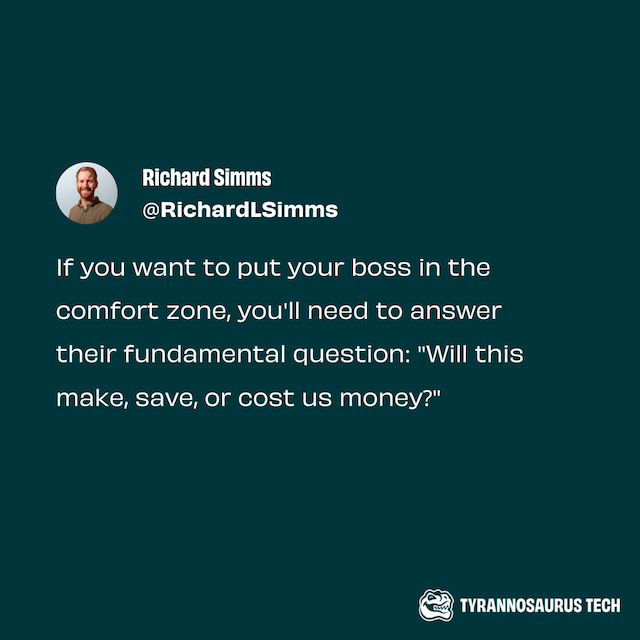For the past three years, business owners and executive leaders have been walking a tightrope.
Between a tough economy, mass layoffs, and a scramble to keep up with the latest technology trends, there is a lot of pressure to make the right budget decisions.
The temptation to cut costs, including investments in innovation, can be strong.
But if you’re like us, and saw companies fall behind on their tech during the pandemic and never recover, then you know that now is not the time to divest.
So what can you do to help your organization stave off a potentially devastating error?
Help your higher-ups see the bigger picture.
Whether you’re trying to persuade the c-suite to take advantage of ChatGPT, maintain your platform, or prevent a meltdown you’ll need to be strategic with your approach to get your funding approved.
To help strengthen your case, we’re sharing our playbook of the 6 most powerful tips for getting your budget backed:
Tip #1. Tailor The Conversation
Do you know what truly motivates your boss?
Let’s start with the basics: Most human beings are driven by a healthy amount of self-interest.
So if you want to craft a compelling pitch, begin by personalizing the conversation for the person(s) receiving it. For high-achieving execs, that may include looking good in front of their boss, the rest of C-suite, their board, or their investors, as well as hitting company goals.
Next, you’ll want to fine tune your pitch for clarity.
Too often we see managers who assume a busy boss will automatically connect the dots based on what you’re recommending. To rise above the mental fray, your pitch must include:
- A clearly framed problem or opportunity
- Explanation of the expected impact
- Data or visuals to back it up
- 2-3 recommendations
Not only is clear messaging a good business practice, but it also helps create cognitive ease.
As behavioral economist Daniel Kahneman explains in his best-selling book, Thinking, Fast and Slow, when we are in a state of cognitive ease we tend to believe what we hear, feel like the current situation is comfortable and familiar, and become a bit less skeptical of the message.
Once you’ve identified which camp your request falls in, speak to it with data.
Show that you’ve done your research and thought about how this decision impacts the business.
When possible, outline hard numbers that demonstrate the tangible benefits of investing in technology and tie those back to the company’s goals and KPIs.

Tip #2. Doing Nothing Costs Something
Research consistently shows humans are more driven to avoid losses than to pursue gains.
During the double whammies of the pandemic and AI revolution tech companies in atlanta learned how quickly being stagnant accumulates technical debt or leads to loss of competitive advantage.
For companies invested in technology, simply halting all spending is unrealistic. Technology requires ongoing maintenance to ensure systems are performant and secure. Failure to recognize this can have dire consequences.
Remember Southwest airlines holiday meltdown? Us too.
Recent history is filled with companies’ whose code debt caught up to them in the most embarrassing or damaging ways.
Just because you’re taking your foot off the gas doesn’t mean your competitors will do the same.
By framing both the opportunity and the risk of inaction as potential threats to your competitive edge, you’ll help your boss maintain a clear-eyed perspective.
The key is to spark a valid sense of urgency, while offering simple ways to mitigate risks.
Tip #3. Aim For Incremental Cost Approval
It’s time to bury the “go big or go home” mentality.
In today’s economy, getting budget approval is all about “start small and prove it.” If you come of the gate pushing for one big round budget number, your boss is likely to balk.
Besides, with the proliferation of SaaS and subscription models, decision makers at tech companies in atlanta are more accustomed to monthly costs. Oftentimes, this single shift in how the total price is presented makes it palatable.
To execute this tactic within your proposal try:
- Presenting a low-cost entry point
- Structuring pricing based on a monthly cost
- Building in progressive checkpoints to evaluate value
- Asking for a starter stipend to validate your proposed solution
Ultimately, the lower the stakes, the easier it will be for your higher ups to say “yes.”
Tip #4. Get Buy-In From Your Boss’ Trusted Advisors
Your boss is a human being.
Which means, like all people, they are influenced by the opinions of their “tribe.” Your job is to figure out whose input they value most at work and to get their support.
It sounds counterintuitive, but great leaders will appreciate your initiative.
Here’s why: Like most owners of tech companies in atlanta, we are usually pressed for time. So when faced with an important decision, we consult the colleagues we trust.
These are usually folks who are:
- Senior stakeholders
- Long time team members
- Experts in the areas we aren’t
- Experienced with similar projects
Nothing makes it easier to say “yes” than asking two other confidants and finding out they’re already briefed and on board.
In fact, we’ve found our sharpest employees know the best way to move something forward is to get their buy-in beforehand.
Tip #5. The Power of Options: Never Allow “No” in the Equation
If you don’t want to weaken an excellent proposal, never include “no” as an option.
When launching T-Rex Tech, we implemented a tactic from Richard’s early career in sales: people are naturally wired to pick from the options presented.
Think: Multiple choice quiz.

In fact, decision makers usually see the middle option as most prudent.
Instead of simply asking for a binary “yes” or “no” answer, present your boss with 2-3 different courses of action you strongly believe in.
Here’s what it looks like:
Let’s say you’re looking to secure an additional $10,000/month budget to redesign your app’s user interface.
Option #1
👉 $12,500/month – Allows for your dream redesign with all the bells and whistles
Option #2
👉 $10,000/month – Exactly what you need to execute an excellent redesign
Option #3
👉 $7,500/month – Requires some constraints but gets the job done
Be sure to outline how each recommendation benefits the company and mention any potential downsides or tradeoffs.
Your boss is much more likely to gravitate towards one of those alternatives than going straight to “no.”
And you are more likely to come out of the meeting with a win.
Tip #6. Develop Tangible Assets To Support Your Case
To win over any audience when presenting: Use 👏 Visual 👏 Aids 👏
In business, many believe using visuals in a presentation should be reserved for client pitches.
Do not listen to those people. They are ignoring basic biology.
Here’s why:
- 65% of humans are visual learners
- Our brains process visual information ~60,000 times faster than text
- Studies show when audiences heard the same presentation, 67% were persuaded by the one with visuals vs. 50% by a purely verbal presentation.
In addition to chart and diagrams, here are some other graphics you might be overlooking:
- Infographics
- Screenshots
- Forecasted timeline
- Clickable prototypes
- Customer testimonials (showing how other companies have benefited from similar investments)
If you want to explore what your next innovation project requires before asking your execs to make a major financial investment, we can help develop the materials with a T-Rex Tech Design & Discovery package.
Putting It All Together
By understanding what motivates your boss, aiming for incremental cost approvals, remembering that doing nothing costs something, enlisting your exec’s trusted advisors, presenting multiple courses of action, and developing tangible assets, you will create an ironclad proposal for any kind of technology investment.
Be prepared to answer questions about how this new budget will benefit the team and be sure to demonstrate why it is necessary for business success. With a clear strategy, you can convince your boss that approving your tech budget is the right move for all involved.
Good Luck!


